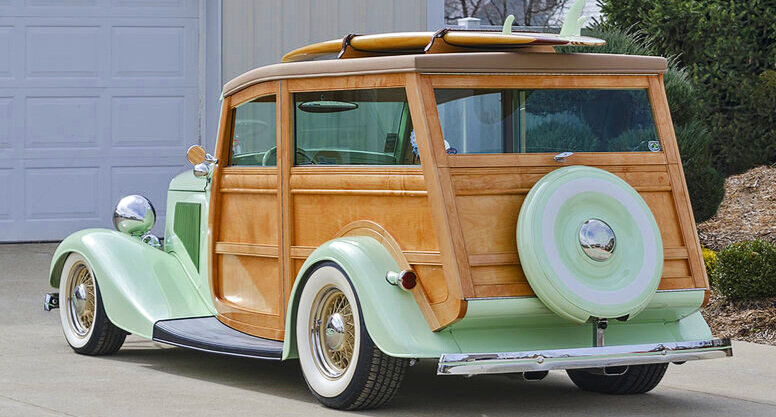(from tunnelram.net)
“I got a ‘30 Ford wagon and we call it a woodie…you know it’s not very cherry it’s an oldie but a goodie” - lyrics to Jan & Dean’s 1963 number one hit ‘Surf City’
The iconic American woody (or woodie) wagon dates back to the very beginning of automobile manufacture when car frames were originally made of timber. As metal took over and timber content diminished throughout the 1920s - certain models stubbornly refused to go all-metal. The sheer craftsmanship required to fashion doors, frames and panels out of wood necessitated more time, care and cost. As a result, station wagons with wooden bodies took on an aura of prestige and old world elegance. Pulling up to the country club or golf course in a wooden-bodied wagon became fashionable.
As the automobile matured, so did steel-stamping techniques. Over the decades, steel replaced hardwood in many applications, including frames, fenders, and hoods. Yet manufacturers and custom-body builders still used wood for major sections from the windshield back for station wagons, sedans, convertibles, and trucks. The 1929 Ford Model A station wagon is widely believed to be the first truly mass-produced woodie wagon.
As use of steel became more widespread, designers used wood more for styling. Steel improved body strength and durability, but customers continued to call for the warm look of wood. In a reversal of sorts, as steel stamping became cheaper and commonplace, genuine wood trim became a luxury, the workmanship recalling old-worlde charm.
While genuine woodies fell out of favor with mainstream buyers and manufacturers due to a lack of durability and increasing cost of production, pre-loved examples found a second life in Southern California. The climate helped preserve the wood, while the commodious interiors proved ideal for surfers to haul their friends and boards to SoCal beaches.
The woody wagon was for several decades the equivalent to today’s high-end SUV and so remained on many auto-makers books long after they should have been consigned to history. The last true American woody was the 1953 Buick Estate Wagon, though even it had all steel doors with wood panels.
In England, thanks to the Morris Traveler and Mini Clubman - the woody lived on a while longer in diminutive form. The Austin Mini Countrymen was made right up until 1969 and along with the Morris Traveler remains a much-loved classic woody in the British Isles.
From 1954 the true American woody wagon was no more, in its place manufacturers offered station wagons with wood paneling only. Within a few years even the paneling was no longer made of timber. From the mid to late 1950s manufacturers evoked timber construction with vinyl appliques of simulated wood grain, often augmented with simulated framework, and later by a simple series of indented grooves in the bodywork.
Meanwhile the price of original woodies soared as they became scarce. Wood rot saw most end up in scrapyards or left to slowly die on farms, but many have been painstakingly restored and are prized by those with a love for west coast surf culture. Commanding respect now, a restored woody is a bona fide classic car fetching high prices at auction.
The iconic status of woody wagons has nothing to do with their original estate pretensions, but due to their use by young surfers as a cheap way to get their malibu boards from beach to beach through the ‘50s and ‘60s. Some 60 years later it’s impossible to overstate how incredibly influential surfing culture became almost overnight in the US. Kids were buying surfboards in the midwest, attaching boards to the roof of their jalopy despite being 500 miles from the nearest beach. The Beachboys were the biggest band in America - spreading the gospel of SoCal surf culture from coast to coast and everywhere in between. Suddenly everyone wanted an old woody wagon just like the kids on surfin’ safaris in Beachboys and Jan and Dean songs. The woody was cool.
Thanks to numerous, expensive restoration projects, woody wagons can once again be seen in the parking lots at Little Rincon, Big Sur and Malibu. No longer cheap jalopies - a restored woodie is now an expensive, prized possession.
Although not a true woody, in the 1980s the Wagon Queen Family Truckster as featured in National Lampoon’s Vacation is probably the most famous woody of them all. Based on a 1979 Ford LTD Country Squire woody wagon, legendary customizer George Barris turned it into something gloriously ugly for the cult movie featuring the Griswold family.
Even Clark Griswold didn’t want the car, but car salesman Ed (Eugene Levy) convinces him: ‘This is a damn fine automobile if you want my honest opinion. You think you hate it now, but wait until you drive it!’ With Chevy Chase at the wheel on a cross-country road trip to Walley World - the Family Truckster drove itself into immortality.
The true woody wagon was already there…not at Walley World, but at immortality - all thanks to surf mad teenagers and the Beachboys, 60 years ago. Long live the woodie.
https://www.tunnelram.net/news-blog/2020/7/14/the-woody-wagon-a-pop-culture-icon


No comments:
Post a Comment